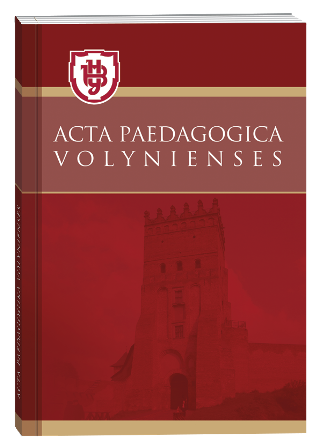СУТНІСНИЙ АНАЛІЗ ПОНЯТТЯ «МІЖОСОБИСТІСНОЇ ВЗАЄМОДІЇ» ВИХОВАТЕЛЯ ЗАКЛАДУ ДОШКІЛЬНОЇ ОСВІТИ
DOI:
https://doi.org/10.32782/apv/2022.1.1.19Ключові слова:
взаємодія, міжособистісна взаємодія, суб’єкт-суб’єктна взаємодія, вихованець, вихователь закладу дошкільної освітиАнотація
У статті проаналізовано різні наукові проблеми щодо дослідження дефініцій міжособистісної взаємодії вихо- вателя закладу дошкільної освіти. На основі аналізу наукової літератури висвітлено сутнісний аналіз поняття «міжособистісної взаємодії» вихователя закладу дошкільної освіти. Автором проаналізовано різні підходи до визначення понять «взаємодія» та «міжособистісна взаємодія». З’ясовано, що поняття взаємодії застосовується, по-перше, для характеристики дійсних реальних контактів людей під час сумісної діяльності; по-друге, для опису взаємних впливів один на одного під час сумісної діяльності або в процесі соціальної активності. Під час взаємодії вихователь впливає на мотиви, цілі, прийняття рішень, на виконання і контроль дій, тобто на всі складові діяльності вихованця (партнера). Зокрема, автором досліджено, що до структури взаємодії входять: суб’єкти взаємодії, взаємний зв’язок, взаємний вплив один на одного, взаємні зміни суб’єктів спілкування. При цьому взаємодія складається з дій, які визначають: діючий суб’єкт; об’єкт дії чи суб’єкт, на який спрямовано вплив; метод дії чи спосіб використання засобів впливу; реакцію індивіда, на якого впливають, чи результат дії. Визначено, що взаємодія суб’єктів освітнього процесу є міжособистісною взаємодією – особистісним контактом двох і більше осіб, зумовлена потребою у спільній діяльності, наслідком якого є взаємні зміни у їхній поведінці, діяльності, установках. Це узгоджена діяльність задля досягнення спільних цілей та результатів, вирішення учасниками значущої для них проблеми чи завдання. Зокрема, виділено два основних типи (стратегії) міжособистісної взаємодії: співпрацю (кооперацію), коли просування кожного з партнерів до своєї мети сприяє або, як мінімум, не перешкоджає реалізації цілей інших, та суперництво (конкуренцію), коли досягнення мети одного з індивідів, що взаємодіють, ускладнює або виключає можливість досягнення цілей інших учасників спільної дії. Найбільш ефективною для розвитку вихованця та колективу є співпраця, для якої характерні знання та опора на позитивне в людині, доброзичливість, довірливість, активність обох сторін, діалог. Досліджено, що всі складові міжособистісної взаємодії характеризуються взаємністю і обіймають такі явища як взаєморозуміння, взаємовплив, взаємопізнання, взаємовідношення, сумісність та спрацьованість.
Посилання
Великий тлумачний словник сучасної української мови (з дод. і допов.) / Уклад. В.Т. Бусел. К.; Ірпінь : ВТФ «Перун», 2005. 1728 с.
Ємчик О. Формування інформаційної компетентності вихователя закладу дошкільної освіти. Актуальні проблеми педагогічної освіти: європейський та національний вимір : матеріали V Міжнародної науково-практичної конференції, м. Луцьк, 12–15 жовтня 2020 р. Луцьк. С. 77–78.
Желанова В. Суб’єкт – суб’єктна взаємодія вихователя і вихованців як засіб творчої самореалізації особистості. Педагогічний часопис Волині. 2016. № 2. С. 71–76. Режим доступу: http://nbuv.gov.ua/UJRN/pchv_2016_2_16
Ковальчук З.Я. Специфіка міжособистісної взаємодії педагога та адміністрації освітнього закладу. Проблеми сучасної психології : збірник наукових праць (Березень 21, 2019). Режим доступу: http://vnv.asv.gov.ua/index.php/2227-6246/article/view/160444.
Коломинский Я.Л. Учителю о психологии детей шестилетнего возраста: книга для учителя. Москва : Просвещение, 1988. 190 с.
Коржук О. Чуйне ставлення вихователя до дітей як засіб налагодження педагогічної взаємодії у навчально-виховному процесі ДНЗ. Вісник Інституту розвитку дитини. Серія: «Філософія, педагогіка, психологія». 2014. Вип. 34. С. 101–107. Режим доступу: http://nbuv.gov.ua/UJRN/Vird_2014_34_17
Новий тлумачний словник української мови : у 3-х т. / уклад. В. Яременко, О. Сліпушко. Київ : Видавництво «АКОНІТ». 2001.
Савчин М.В. Особливості міжособистісної взаємодії суб’єктів навчання. Вісник Національної академії Державної прикордонної служби України. 2012. Вип. 1. Режим доступу: http://nbuv.gov.ua/UJRN/Vnadps_2012_1_40
Ситнік С.В. Характеристика та ознаки міжособистісної взаємодії. Наука і освіта. 2014. № 11. С. 156–161. Режим доступу: http://nbuv.gov.ua/UJRN/NiO_2014_11_31







